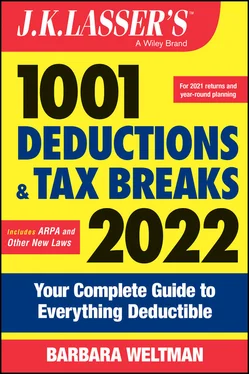Barbara Weltman - J.K. Lasser's 1001 Deductions and Tax Breaks 2022
Здесь есть возможность читать онлайн «Barbara Weltman - J.K. Lasser's 1001 Deductions and Tax Breaks 2022» — ознакомительный отрывок электронной книги совершенно бесплатно, а после прочтения отрывка купить полную версию. В некоторых случаях можно слушать аудио, скачать через торрент в формате fb2 и присутствует краткое содержание. Жанр: unrecognised, на английском языке. Описание произведения, (предисловие) а так же отзывы посетителей доступны на портале библиотеки ЛибКат.
- Название:J.K. Lasser's 1001 Deductions and Tax Breaks 2022
- Автор:
- Жанр:
- Год:неизвестен
- ISBN:нет данных
- Рейтинг книги:3 / 5. Голосов: 1
-
Избранное:Добавить в избранное
- Отзывы:
-
Ваша оценка:
- 60
- 1
- 2
- 3
- 4
- 5
J.K. Lasser's 1001 Deductions and Tax Breaks 2022: краткое содержание, описание и аннотация
Предлагаем к чтению аннотацию, описание, краткое содержание или предисловие (зависит от того, что написал сам автор книги «J.K. Lasser's 1001 Deductions and Tax Breaks 2022»). Если вы не нашли необходимую информацию о книге — напишите в комментариях, мы постараемся отыскать её.
J.K. Lasser's 1001 Deductions and Tax Breaks 2022: Your Complete Guide to Everything Deductible
1001 Deductions and Tax Breaks, 2022
J.K. Lasser's 1001 Deductions and Tax Breaks 2022 — читать онлайн ознакомительный отрывок
Ниже представлен текст книги, разбитый по страницам. Система сохранения места последней прочитанной страницы, позволяет с удобством читать онлайн бесплатно книгу «J.K. Lasser's 1001 Deductions and Tax Breaks 2022», без необходимости каждый раз заново искать на чём Вы остановились. Поставьте закладку, и сможете в любой момент перейти на страницу, на которой закончили чтение.
Интервал:
Закладка:
In 2021, a single parent with one qualifying child age 4 has MAGI of $100,000. The $3,600 credit is reduced to $2,350 (reduction is $1,250, which is $25,000 excess MAGI over the applicable threshold ÷ $50).
TABLE 1.1 Stage 1 Phaseout of the Child Tax Credit over MAGI Limits in 2021
| Filing Status | MAGI Limit |
|---|---|
| Married filing jointly | $150,000 |
| Head of household | $112,500 |
| Single | $ 75,000 |
TABLE 1.2 Stage 2 Phaseout of Child Tax Credit over MAGI Limits in 2021
| Filing Status | MAGI Limit |
|---|---|
| Married filing jointly | $400,000 |
| Other filing status | 200,000 |
ADDITIONAL CHILD TAX CREDIT
If you can't meet the residency test discussed earlier, you may still qualify for a child tax credit that exceeds your tax liability and is refundable to you. The basic child tax credit amount for those not meeting the residency test is $2,000; income limits apply. The refundable portion is limited to $1,400, but no more than either:
15% of earned income in excess of $3,000, or
For those with 3 or more qualifying children, the excess if any of Social Security taxes over the earned income credit.
Planning Tips
The child tax credit and the credit for other dependents should be factored into income tax withholding from paychecks to enjoy the tax savings throughout the year. The amount of the child tax credit in 2022 will be lower unless Congress makes a change. But you may still file a new Form W‐4 with your employer to factor in the applicable child tax credit into your withholdings for the year.
If you know you will become entitled to claim the credit (e.g., you expected the birth of a child), you may wish to adjust your withholding so that you don't have too much income tax withheld from your paycheck. Increase your withholding so that less income tax is withheld from your pay by filing a new Form W‐4, Employee's Withholding Certificate , with your employer. There is a Tax Withholding Estimator at https://www.irs.gov/individuals/tax-withholding-estimatorto help you complete Form W‐4.
If you can't claim a credit for a qualifying child because the child doesn't have a valid Social Security number, you may be able to claim the credit for a qualifying dependent. For example, if there is another taxpayer identification number (e.g., Adoption Taxpayer Identification Number, or ATIN), you may be eligible for the $500 credit.
Pitfalls
If you had a change in income, dependents, filing status, or residency, you may have received more in advance payments of the child tax credit than what you are actually entitled to, based on 2021 income, dependents, filing status, and residency. You may have to repay some or all of the excess advance payments received.
There's no repayment required if your modified adjusted gross income (MAGI) for 2021 does not exceed $40,000 for singles, $50,000 for heads of households, or $60,000 for joint filers as long as your principal place of abode was in the U.S. for more than half the year.
There may be repayment if MAGI for 2021 is between $40,000 and $80,000 for singles, $50,000 and $100,000 for heads of households, or $60,000 and $120,000 for joint filers as long as your principal place of abode was in the U.S. for more than half the year. It depends on the “repayment protection amount,” which is $2,000 multiplied by the number of children used to figure your advance payments minus the number of children used to figure the total credit amount on your 2021 return. If the number of children is the same, then the overpayment must be repaid (i.e., there is no repayment protection amount). If there is a repayment protection amount, then there is a reduction in what must be repaid.
There's full repayment if MAGI is at least $80,000 singles, $100,000 for heads of households, or $120,000 for joint filers.
If you claim the foreign earned income exclusion to exclude income earned abroad up to the annual dollar limit ($108,700 in 2021), you cannot receive the refundable child tax credit.
For 2021 returns filed in 2022, the IRS is not permitted to issue tax refunds for the refundable child tax credit before mid‐February 2022. As a result, refunds usually aren't received until the third or fourth week in February, even for returns submitted in January 2022.
Where to Claim the Credit
On page 1 of Form 1040 or 1040‐SR, enter dependents for whom you are claiming a child tax credit or credit for other dependents, along with their Social Security numbers and relationship to you. The child tax credit—refundable and nonrefundable amounts—as well as the additional child tax credit are figured on Schedule 8812 of Form 1040 or 1040‐SR. The nonrefundable child tax credit or the credit for other dependents is entered on line 19 of the return. The refundable child tax credit or the additional child tax credit is entered on line 28 of the return.
Earned Income Credit
Low‐income taxpayers are encouraged to work and are rewarded for doing so by means of a special tax credit, called the earned income credit. The earned income credit is the second‐largest program, after Medicaid, that provides assistance to low‐income people. The amount of the credit varies with income, filing status, and the number of dependents, if any. The credit may be viewed as a “negative income tax” because it can be paid to taxpayers even if it exceeds their tax liability.
TABLE 1.3 Maximum Earned Income Credit for 2021
| Maximum Earned | |
|---|---|
| Number of Qualifying Children | Income Credit |
| No qualifying child | $ 1,502 |
| 1 qualifying child | 3,618 |
| 2 qualifying children | 5,980 |
| 3 or more qualifying children | 6,728 |
Benefit
If you are a working taxpayer with low or moderate income, you may qualify for a special tax credit of up to $6,728 in 2021. The amount of the credit depends on several factors, including your adjusted gross income, earned income, and the number of qualifying children. Table 1.3 shows the maximum credit you may claim based on the number of your qualifying children, if any.
The credit is “refundable” because it can be received in excess of the tax owed.
Conditions
To be eligible for the credit, you must have earned income from being an employee or a self‐employed individual. The amount of the credit you are entitled to claim depends on several factors.
QUALIFYING CHILDREN
You may claim the credit even if you have no qualifying child. But you are entitled to a larger credit if you have one qualifying child and a still larger credit for 2 or more qualifying children.
To be a qualifying child, the child must:
Be a qualifying child as defined earlier in the chapter under the child tax credit
Be under age 19 or under age 24 and a full‐time student or permanently and totally disabled
Live in your U.S. household for more than half the year
Qualify as your dependent if the child is married at the end of the year
Be a U.S. citizen or resident (or a nonresident who is married to a U.S. citizen and elects to have all worldwide income subject to U.S. tax)
EARNED INCOME
Earned income includes wages, salary, tips, commissions, jury duty pay, union strike benefits, certain disability pensions, U.S. military basic quarters and subsistence allowances, and net earnings from self‐employment (profit from your self‐employment activities). Military personnel can elect to treat tax‐free combat pay as earned income for purposes of the earned income credit.
Читать дальшеИнтервал:
Закладка:
Похожие книги на «J.K. Lasser's 1001 Deductions and Tax Breaks 2022»
Представляем Вашему вниманию похожие книги на «J.K. Lasser's 1001 Deductions and Tax Breaks 2022» списком для выбора. Мы отобрали схожую по названию и смыслу литературу в надежде предоставить читателям больше вариантов отыскать новые, интересные, ещё непрочитанные произведения.
Обсуждение, отзывы о книге «J.K. Lasser's 1001 Deductions and Tax Breaks 2022» и просто собственные мнения читателей. Оставьте ваши комментарии, напишите, что Вы думаете о произведении, его смысле или главных героях. Укажите что конкретно понравилось, а что нет, и почему Вы так считаете.












